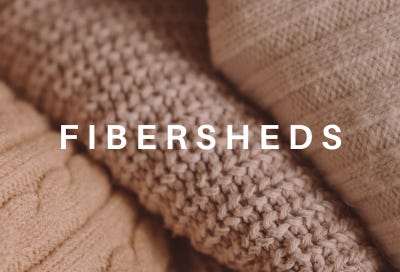Most of us passionate about soil health are concerned with where our food comes from, but how often do you consider the relationship between soil and the clothes you wear?
Fiber, like food, is an essential part of every human life. As such, our choices as consumers – how we buy and dispose of clothing – can have a significant environmental impact.
Our upcoming posts on the journey from soil to skin, are inspired by the work of Katie Troutman. Katie has navigated the complex system of fiber and fashion and, in her own unique way, is bringing awareness to the challenges and possibilities of closing the loop on clothing. 🔄
Katie is the Founder of the Texas Fibershed and the creative force behind an ever-evolving, nature-inspired clothing company aptly named, Tend.
We first connected through Jessi Roesch of Downland. At that time, Katie had a garment sample – women’s underwear – actively decomposing at a local worm farm. 🩲🪱 As you can imagine, I delighted in this! Katie surprised me even further with her genuine concern for the microbial life, “I want to make sure nothing is harmed by this product”. So, naturally I ‘scoped that out for her. 🔬
Since then, I’ve had the pleasure of composting the undies myself and interviewing Katie about her journey of creating Tend. Over the coming weeks I’ll be sharing her insights and experiences! To begin, let’s explore the concept central to her mission: fibersheds.
What’s a Fibershed?
Just as a “watershed” describes the flow of water within a defined area, a “fibershed” refers to a geographical region capable of producing textiles - from sourcing fibers and dyes to processing them into finished products.
As you can imagine, textile manufacturing is a globalized process these days. The making of a single garment is often a fragmented and dispersed journey. The concept of a fibershed challenges this norm by advocating for localized, integrated textile production.

A Brief History of Fibershed (the organization)
In 2010, educator, textile artist and slow fashion enthusiast, Rebecca Burgess set out to wear only clothes that were made from fibers grown, woven and sewn within a 150-mile radius of her home in Marin County, California. Despite the simplicity of the “150-mile wardrobe project”, it proved to be an ambitious challenge that underscored the lack of infrastructure for local textile production.
The relationships forged and insights gained from this project inspired the creation of the non-profit organization, Fibershed in 2011. Fibershed aims to…
Promote Climate-Beneficial Agriculture: support farming practices that enhance soil health and sequester carbon
Rebuild Regional Manufacturing: stimulate the revival of local textile production
Educate and Connect: link consumers with the origins of their clothing through educational initiatives
(this is a paraphrasing of Fibershed’s mission)
Formalizing the concept of a fibershed into an actual organization has sparked the creation of fibershed communities across the United States and beyond. At their core, each fibershed is focused on developing a network of sustainable textile production within the context of their unique bioregion.
The Intersection of Fibershed and Tend
When Katie Troutman, our guest this month, discovered the work of Rebecca Burgess and Fibershed it felt like finding a missing piece to the puzzle.
“Finding Fibershed was a pivotal moment for me… It became an anchor point. Something in me just told me to follow that path, to follow nature.”
Katie was particularly inspired by Fibershed’s open-source model and its ethos of information sharing and local fiber-based business
“How they were structured inspired me in so many ways,” she reflects. “Fibershed reshaped my idea of what success could look like for Tend.”
At the time, Katie was researching biomimicry and material design. Learning about Fibershed’s concept illuminated a new direction for her.
“I realized that in order to make the product I want to make, it needs a fibershed. There wasn’t a Texas fibershed so I thought, well… I guess I’ll start one.”
Tend is, in essence, a scaled-down version of the 150-mile challenge. Rather than building an entire wardrobe, Katie’s goal is to create a locally sourced undergarment.
Can it be done? Stay tuned for next week’s post to find out!

As a consumer, and wearer of clothing, what’s your experience been like sourcing, mending, and elongating the life of your clothes?!
Personally, I’ve found improving the sourcing of food and composting waste has been challenging itself, and clothing is so much harder, ha. 😅 But, I find it to be a worthwhile goal (and fun!) to keep working towards.
From the bottom of my heart, thank you for reading. If you think someone would enjoy this series of posts on fiber, please forward on 🤎
Resources:
Fibershed
Texas Fibershed





